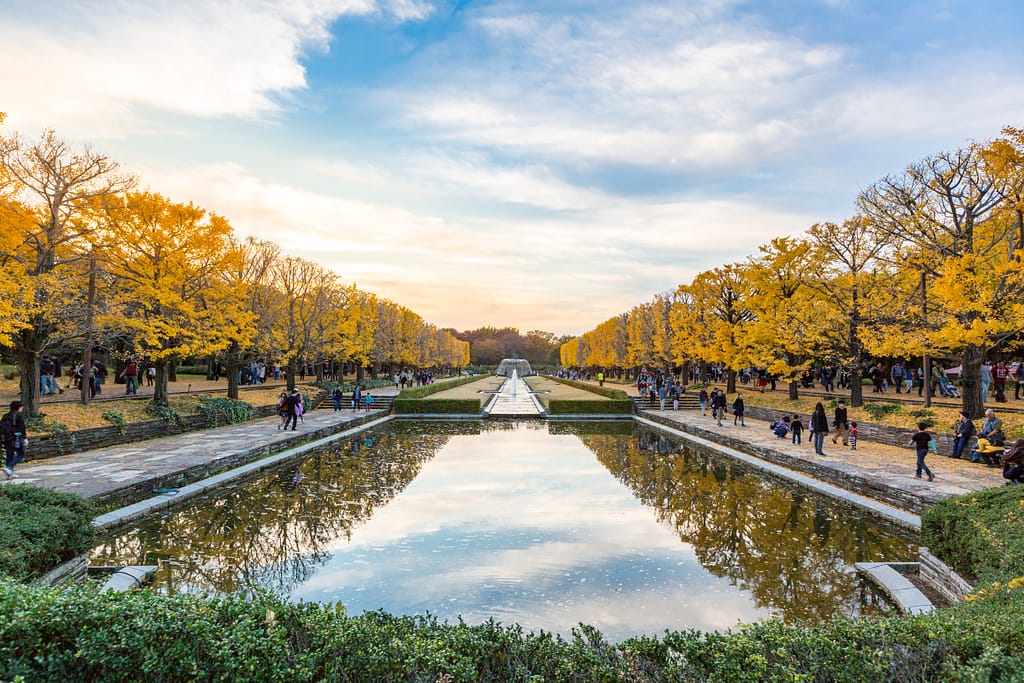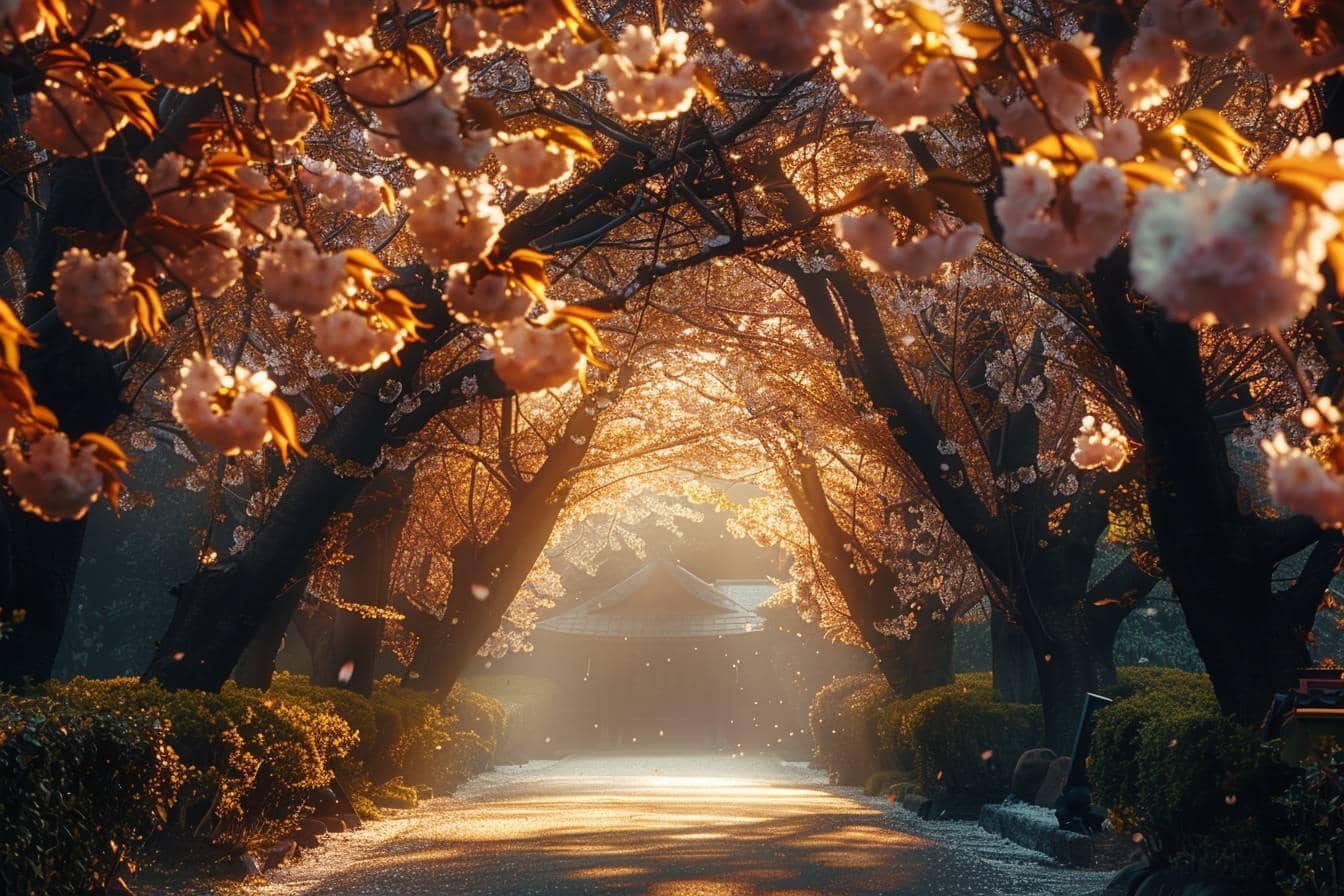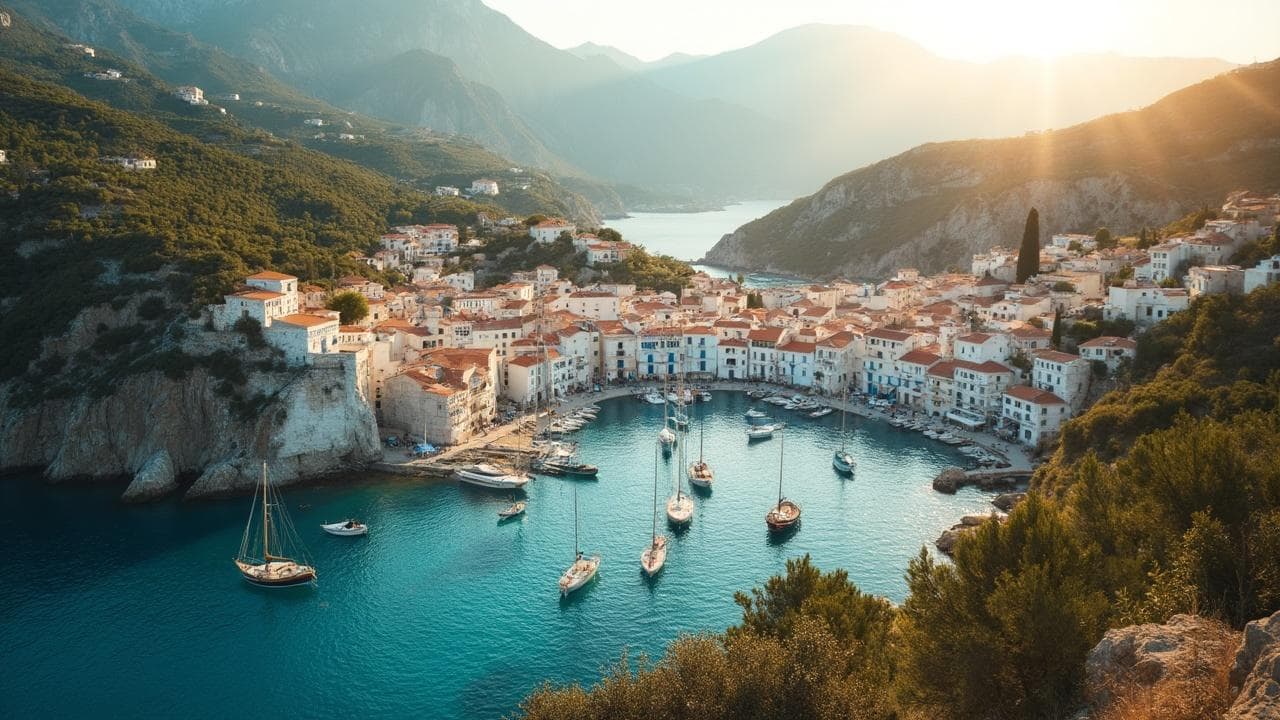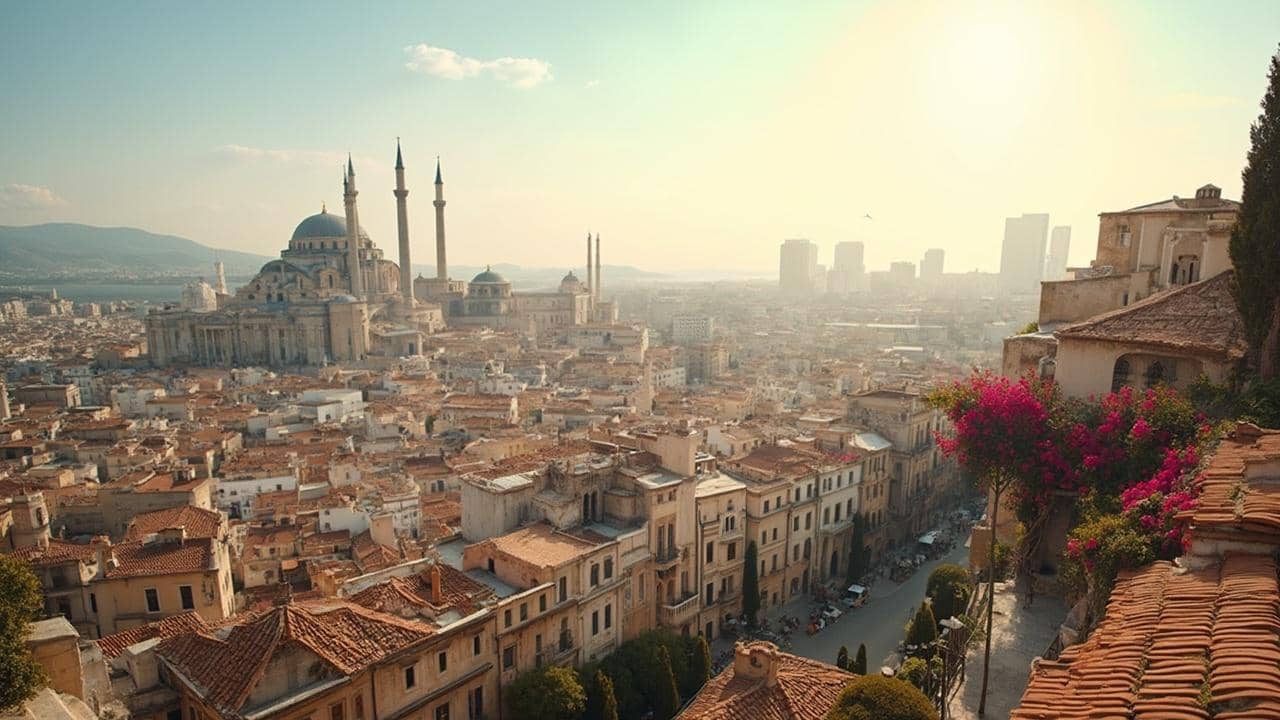Imagine wandering down a path where the vibrant yellows of ginkgo leaves form a surreal canopy above. Welcome to the Yellow Spring Road in Hirokawa, Japan, a hidden gem that unfolds its beauty in the serene precincts of Wakayama Prefecture.
This road transforms into a breathtaking tableau each autumn, drawing travelers and photography enthusiasts eager to capture its charm.
In this article
- The serene beauty of Yellow Spring Road
- History and Cultural Significance
- Local festivities and events
- Photographic Paradise at Yellow Spring Road
- Seasonal changes
- Flora and Fauna
- Visiting and Accommodations
- Frequently asked questions about Yellow Spring Road
- Wrap up
Yellow Spring Road, known locally as “Koganezaka” (黄金坂), is a picturesque stretch of road in Hirokawa, Wakayama Prefecture, Japan.
This enchanting location has captured the hearts of locals and tourists alike. It uniquely blends natural beauty, cultural significance, and photographic opportunities.
The serene beauty of Yellow Spring Road
My journey to Yellow Spring Road was as spontaneous as it was memorable. Captivated by a photograph I stumbled upon while browsing an online travel forum, I knew I had to witness this enchanting scene myself.
So, I packed my gear and set out for Hirokawa—a decision that led to one of my travels’ most visually stunning experiences.
The road stretches over 300 meters and is lined by over 140 ginkgo trees on either side. Planted in the early 1900s, these trees create a visually arresting golden tunnel in fall, symbolizing resilience and longevity in Japanese culture.
The unique alignment of ginkgo trees alongside the road and their dense golden foliage creates a natural tunnel that seems almost crafted by an artist’s hands.
As you stroll along the path, the rustling leaves create a serene soundscape while the soft sunlight filters through the golden canopy, casting a warm glow that feels almost magical.
The flat terrain of Yellow Spring Road makes it accessible to visitors of all ages and abilities, allowing everyone to enjoy this splendid natural display without strain.
This accessibility contributes to its popularity among locals and tourists, making it a must-visit destination for those exploring Wakayama Prefecture.
History and Cultural Significance
Yellow Spring Road is not just a feast for the eyes but also a site of cultural importance.
The ginkgo tree, known in Japan as “icho” (銀杏), has been revered for centuries for its medicinal properties and as a symbol of hope and longevity.
The road’s creation was part of a larger urban planning initiative in the early 1900s to beautify the area and provide a space for community gatherings.
The ginkgo trees lining the road have become deeply intertwined with local culture.
They symbolize endurance and resilience, reflecting the spirit of the Hirokawa community.
Over the years, Yellow Spring Road has evolved into an integral part of Hirokawa’s identity, drawing visitors from across Japan and worldwide who come to witness its beauty and absorb its cultural significance.
Local festivities and events
Autumn, in particular, is celebrated with various local events that complement the natural splendor of the road.
The highlight of these festivities is the Ginkgo Festival, typically held in mid-November. This vibrant celebration features live music performances that echo through the Golden Tunnel, traditional dance exhibitions that showcase local culture, and food stalls offering a taste of regional specialties.
One of the unique experiences at the Ginkgo Festival is the ginkgo leaf tea tasting sessions.
Visitors can sample this local delicacy, known for its subtle flavor and potential health benefits.
Craft workshops using ginkgo leaves allow participants to create memorable souvenirs, fostering a deeper connection with the local environment.
Beyond the autumn festival, Yellow Spring Road remains a year-round attraction.

Photographic Paradise at Yellow Spring Road
For a digital nomad and photography enthusiast like myself, Yellow Spring Road presented an irresistible opportunity to capture the transience of autumn. The best times for photography are early morning or late afternoon when the light is mellow, creating a perfect luminance that enhances the golden hues of the leaves.
Here’s a small tip for fellow photographers: try visiting on a weekday to avoid the crowds and capture clean, uninterrupted shots.

The natural arch formed by the ginkgo trees along the road offers multiple perspectives and compositions.
Whether you’re aiming for close-up shots that detail the texture of the leaves or wide shots that capture the sweeping grandeur of the canopy, Yellow Spring Road provides many photographic opportunities.
Key photography spots include the midway point of the road, where the canopy is most dense, and the northern end, where the road curves, adding a dynamic element to compositions.
Experimenting with light and shadow play under the yellow canopy can yield captivating images.
Wide-angle lenses are useful for sweeping shots encompassing the ginkgo canopy’s grandeur.
Focusing on individual leaves or the interplay of light through the foliage can produce striking macro images for those interested in detail shots.
Seasonal changes
While Yellow Spring Road is most famous for its autumn colors, each season offers a unique perspective on this natural wonder.
Spring brings delicate new leaves to the ginkgo trees, occasionally complemented by cherry blossoms in nearby areas.
The soft greens of new growth create a fresh, vibrant atmosphere.
Summer transforms the road into a lush green canopy, providing welcome shade from the heat.
The dense foliage creates a cool, tranquil environment perfect for leisurely walks.
The contrast between the bright summer sky and the deep green leaves offers its own photographic opportunities.
Autumn, of course, is the star season.
The ginkgo leaves turn a spectacular golden hue from mid-November to early December, creating the famous golden tunnel effect.
This is when the road is at its most picturesque and attracts the most visitors.
Winter strips the trees bare, revealing the intricate structure of branches against the sky.
While less colorful, this season offers a stark beauty and the opportunity to appreciate the trees’ form and resilience.
On clear days, the winter sun casts long shadows through the bare branches, creating a striking interplay of light and shadow.
Flora and Fauna
Beyond the famous ginkgo trees, Yellow Spring Road and its surrounding area are home to diverse plant and animal life.
Notable flora and fauna:
- Understory plants: ferns, mosses, and seasonal wildflowers
- Birds: Japanese white-eyes, bulbuls, and occasional migratory species
- Insects: butterflies, beetles, and cicadas (especially in summer)
Visiting and Accommodations
Best Time to Visit
Although the road is stunning year-round, the best time is between mid-November and early December when the ginkgo leaves are at their peak golden hue.
If you’re planning a visit, check local weather forecasts and road conditions, as the area can be pretty crowded during the peak season.
How to get there
Traveling to Yellow Spring Road is an adventure in itself.
Located just a day’s trip from Tokyo, it can be reached by train to Hirokawa Station, followed by a short bus ride towards the suburbs where the road is situated.
If you’re driving, there’s ample parking available at the beginning of the road, which is quite convenient.
Accommodations
Hirokawa offers a variety of accommodations, from traditional guesthouses known as ‘Ryokans’ to modern hotels.
I stayed at a small Ryokan, just a few kilometers from Yellow Spring Road, during my visit.
It was a delightful experience, complete with tatami mats and local cuisine, adding an authentic touch to my journey.
Nearby Attractions
While Yellow Spring Road is the main draw, there are several other attractions in the area worth exploring:
- Hirokawa Shrine: A historic Shinto shrine with beautiful architecture
- Koyasan: A UNESCO World Heritage site and center of Japanese Buddhism (day trip)
- Wakayama Castle: Impressive feudal castle with panoramic views (30-minute drive)
- Shirahama Beach: Famous white sand beach and onsen resort (1.5-hour drive)
Environmental Conservation Efforts
The local community and government have implemented several initiatives to preserve Yellow Spring Road for future generations:
- Regular tree health checks and maintenance
- Visitor education programs on environmental conservation
- Restricted vehicle access during peak seasons to reduce pollution
Local Cuisine and Specialties
Visitors to Yellow Spring Road can also enjoy local culinary delights:
- Ginkgo nut dishes: Various traditional recipes using ginkgo nuts
- Wakayama ramen: A local variation of the popular noodle dish
- Mikan oranges: Wakayama is famous for its citrus fruits
- Umeshu: A sweet plum liqueur produced in the region
Tips for Visitors
- Wear comfortable walking shoes
- Bring a camera or smartphone for photos
- Check weather forecasts before visiting
- Consider joining a guided tour for in-depth information
- Respect local customs and environment (don’t pick leaves or litter)
Frequently asked questions about Yellow Spring Road
For those planning to explore this exquisite locale, here are some quick facts and tips :
- How long is Yellow Spring Road? The road stretches approximately 300 meters, making it a short but incredibly picturesque walk.
- Are there guided tours available? During peak season, local tour operators offer guided walks that delve into the area’s history and cultural significance.
- Is there an entrance fee? Access to Yellow Spring Road is free, although some events and festivities nearby may charge a small fee.
- Is photography allowed? Photography is encouraged, but drone use requires prior permission from local authorities.
- Are there facilities available for visitors? Near the road’s entrance, there are public restrooms and small shops.
Wrap up
Yellow Spring Road in Hirokawa, Japan, is more than just a beautiful location—it celebrates nature’s beauty, cultural heritage, and artistic expression.
Whether you’re there to capture stunning photographs, immerse yourself in local culture, or simply enjoy a peaceful walk under a golden canopy, this enchanting road promises an unforgettable experience in one of Japan’s most stunning landscapes.




